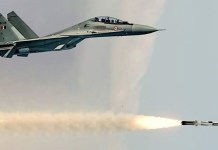Iran has supplied Hezbollah and other Iranian proxy forces with electromagnetic ordnance, which can disable communication systems and shut down radars, according to a report by the Kuwaiti newspaper Al-Jarida.
“Think of the analogy from the 1960s, which describes that in a nuclear explosion, only the cockroaches would survive. In the same vein, in an electromagnetic attack, the ‘cockroaches’ (a nickname for electronic components in electrical circuits) will not survive this time. It will affect all of us in our daily lives and emergency preparedness”, said Rotem Mey-Tal, CEO of Asgard Systems and a military weapons expert from Israel.
Asgard Systems is a company developing military technology for the defense industry and the initiator of the “30U30 in Defense” competition for 2024. Mey-Tal made these remarks while speaking to ‘The Jerusalem Post.’
IRGC Supplies Hezbollah With Advanced Bombs?
An Iranian source claims that the Islamic Revolutionary Guard Corps (IRGC) recently supplied Lebanese Hezbollah with a shipment of ‘qualitative weapons’ as the terrorist group prepares for an invasion of Israel’s Galilee and Golan Heights regions.
Media reports suggest that these weapons, which include bombs, are designed to disrupt entire electronic networks with effects comparable to nuclear strikes. Some of these bombs can be launched from stationary platforms, while others can be attached to drones to strike targets deep within Israel.
The report also states that these bombs “could destroy all communications systems, including the electricity infrastructure,” within minutes of an Israeli military operation against Hezbollah.
What Is Electromagnetic Ordnance?
Electromagnetic ordnance refers to weapons that use electromagnetic energy to disrupt or destroy electronic systems. These devices release intense bursts of electromagnetic radiation that can damage or disable electronic equipment and communication networks.
Their impact can be extensive, potentially causing failures in critical infrastructure such as power grids and communication systems.
Unlike conventional explosives, electromagnetic weapons do not cause physical damage through blasts or shrapnel. Instead, they generate effects similar to an electromagnetic pulse (EMP) from a nuclear explosion but without the accompanying nuclear radiation or physical destruction.
The impact could be likened to a massive, targeted electrical surge impacting a broad area. This surge could render electronic devices inoperable, disrupt power distribution, and interfere with communications, leading to significant societal disruption.
Potential targets of electromagnetic ordnance attacks include military command and control systems, civilian infrastructure (such as power grids and telecommunications), vehicles with electronic systems, and data centers or computer networks.

Hezbollah’s Escalation & Potential EMP Targets
The Lebanese terrorist group Hezbollah continues to provoke a “full-scale war” by carrying out sporadic air assaults on Israel’s border regions.
These attacks have been ongoing since the Israeli Defense Forces’ invasion of Gaza, which followed the Hamas attack in October 2024. Hezbollah is reportedly preparing to invade the Israel-controlled Golan Heights, situated on the border with Jordan and Lebanon, and plans to use electromagnetic pulses (EMP) during this assault.
Rotem Mey-Tal speculated on the possible targets for these weapons, saying, “I suspect the threat is more focused on bases, strategic facilities, desalination systems, and the Israeli power grid. However, it’s impossible to say precisely, as such a weapon has never been used in history, so there are no sources or references to learn from.”
Hezbollah has notably attempted to showcase its ability to deploy drone-launched munitions against Israel. However, according to the Jerusalem Post, these efforts have been largely ineffective, as the militant group has only managed to utilize kamikaze drones.
Hezbollah’s Lethal Rocket Attack
Last Saturday night, a Hezbollah attack resulted in the deaths of 12 children and injuries to more than 40 people, marking the deadliest Hezbollah assault since the group joined the war in support of Hamas on October 8. The attack involved drones, missiles, and rockets fired across the border almost daily.
Israeli Defense Minister Yoav Gallant described Saturday’s deadly Hezbollah rocket attack on Majdal Shams in the Golan Heights as a “terrible tragedy.” He vowed that Iran’s Lebanese terror proxy “will pay the price.”
We mourn the innocent boys and girls killed in Majdal Shams.
There are 150,000 Druze in Israel, as well as millions of Jews and Arab Israelis. We live side by side and all suffer from Hezbollah's terror.
We will ensure Hezbollah, the proxy of Iran, pays a price for this loss.
— יואב גלנט – Yoav Gallant (@yoavgallant) July 28, 2024
On Sunday, IDF Chief of Staff Lt. Gen. Herzi Halevi approved new battle plans for the northern sector in response to Hezbollah’s ongoing attacks.
Last month, Hezbollah leader Hassan Nasrallah threatened a possible invasion of Israeli territory, warning that an invasion of the Galilee remains an option if the conflict escalates.
Potential Threat to U.S. & British Troops
The threat extends beyond Israel. The recently delivered weapons could also pose a threat to U.S. and British troops coming to Israel’s aid, according to reports.
The IRGC, through its proxies, has recently tested “dozens of types of missiles and drones” and gathered extensive intelligence on weapons capable of penetrating air defenses.
This new electromagnetic threat adds another layer of complexity to an already volatile situation in the region.
- Shubhangi Palve is a defense and aerospace journalist. Before joining the EurAsian Times, she worked for E.T. Prime. In this capacity, she focused on covering defense strategies and the defense sector from a financial perspective. She offers over 15 years of extensive experience in the media industry, spanning print, electronic, and online domains.
- Contact the author at shubhapalve (at) gmail (dot) com.




